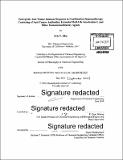| dc.contributor.advisor | K. Dane Wittrup. | en_US |
| dc.contributor.author | Zhu, Eric F. (Eric Franklin) | en_US |
| dc.contributor.other | Massachusetts Institute of Technology. Department of Chemical Engineering. | en_US |
| dc.date.accessioned | 2017-04-05T16:01:02Z | |
| dc.date.available | 2017-04-05T16:01:02Z | |
| dc.date.copyright | 2016 | en_US |
| dc.date.issued | 2016 | en_US |
| dc.identifier.uri | http://hdl.handle.net/1721.1/107872 | |
| dc.description | Thesis: Ph. D., Massachusetts Institute of Technology, Department of Chemical Engineering, 2016. | en_US |
| dc.description | Cataloged from PDF version of thesis. | en_US |
| dc.description | Includes bibliographical references (pages 109-123). | en_US |
| dc.description.abstract | Cancer immunotherapies under development have generally focused on either stimulating T-cell immunity or driving antibody-directed effector functions of the innate immune system such as antibody-dependent cell-mediated cytotoxicity (ADCC). However, as our understanding of antitumor immune responses grows, it has become increasingly apparent that single agent therapies may be insufficient to effectively stimulate all aspects of a complex robust anti-tumor response in a large proportion of patients. Thus, rational combination of single agent immunotherapies has become an area of increasing interest. In this work, we find that a combination of an anti-tumor antigen antibody and an untargeted IL-2 fusion protein with delayed systemic clearance induces significant tumor control in aggressive isogenic tumor models via a concerted innate and adaptive response. We find that this therapy induces the infiltration of various immune effectors such as neutrophils, eosinophils NK cells, and CD8+ T-cells that appear to direct cytolytic activity against tumor cells. This combination therapy also induces an intratumoral "cytokine storm," potentially re-polarizing the tumor microenvironment into one that is immunologically anti-tumor. We also identify cross-talk between NK cells and macrophages to induce intratumoral recruitment of neutrophils but with the requisite presence of anti-tumor antibodies and IL-2 simultaneously. We further enhanced the efficacy of this two-component therapy with the addition of a potent amphiphile-based anti-tumor peptide vaccine in combination with checkpoint blockade of anti-PD-I and anti-CTLA-4. This multi-component therapy was tested in a setting of a low-mutational burden GEM lung cancer model with a single known and targetable antigen: human carcinoembryonic antigen (CEA). We find that in the subcutaneous setting and autochthonous setting, both components of checkpoint blockade are necessary for full efficacy. While a 5- component therapy is admittedly unwieldy for clinical translation, understanding the complementary yet non-overlapping contributions of each agent may inform improved development of additional immunotherapy agents and their combinations in the clinic. | en_US |
| dc.description.statementofresponsibility | by Eric F. Zhu. | en_US |
| dc.format.extent | 123 pages | en_US |
| dc.language.iso | eng | en_US |
| dc.publisher | Massachusetts Institute of Technology | en_US |
| dc.rights | MIT theses are protected by copyright. They may be viewed, downloaded, or printed from this source but further reproduction or distribution in any format is prohibited without written permission. | en_US |
| dc.rights.uri | http://dspace.mit.edu/handle/1721.1/7582 | en_US |
| dc.subject | Chemical Engineering. | en_US |
| dc.title | Synergistic anti-tumor immune response to combination immunotherapy consisting of anti-tumor antibodies, extended half-life Interleukin-2, and other immunomodulatory agents | en_US |
| dc.title.alternative | synergistic anti-tumor immune response to combination immunotherapy consisting of anti-tumor antibodies, serum-persistent Interleukin-2, and other immunomodulatory agents | en_US |
| dc.type | Thesis | en_US |
| dc.description.degree | Ph. D. | en_US |
| dc.contributor.department | Massachusetts Institute of Technology. Department of Chemical Engineering | |
| dc.identifier.oclc | 976406134 | en_US |
